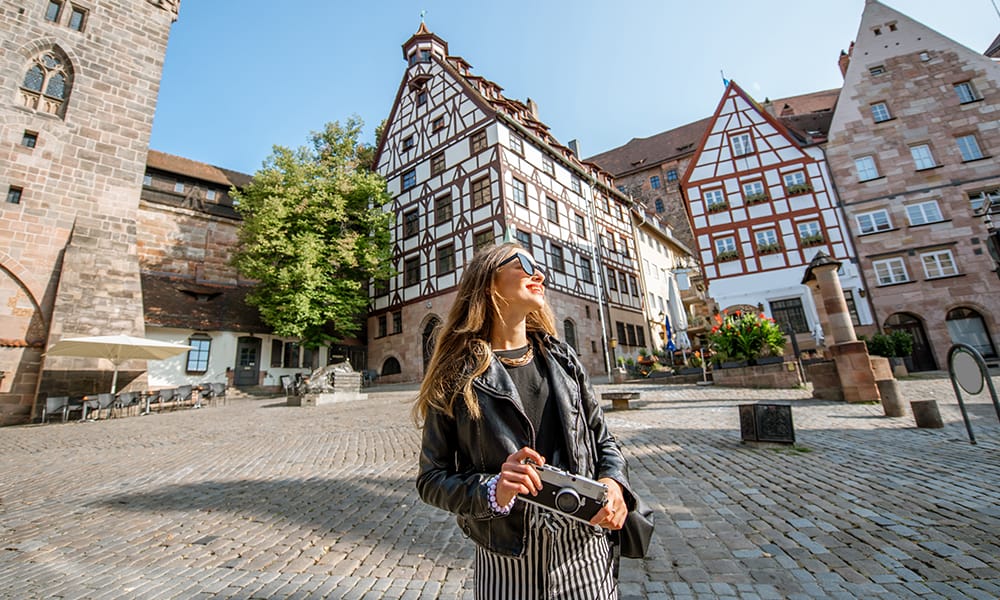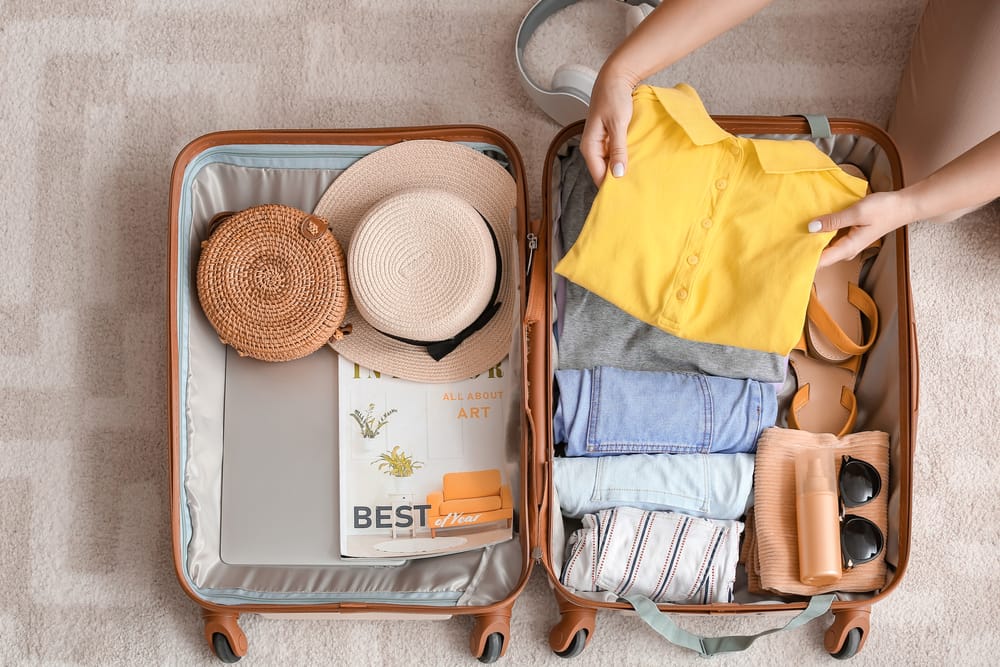Hello jet-setters! Welcome to your one-stop guide, “The Ultimate Packing List for Germany”—tailored to help you navigate your way around the suitcase no matter which part of this eclectic European paradise you're exploring. Whether it's the fairy-tale castles nestled in the Bavarian Alps, the charm-filled alleys of Heidelberg, or the pulsating energy of Berlin, we've got the inside scoop on what to wear and when. We'll take a deep dive into the seasonal sartorial shifts and arm you with tips to keep you comfy, chic, and adventure-ready. So, grab your luggage and let's get packing for the German getaway of a lifetime!
Top style tips for Germany
- Embrace Casual Elegance: Germans often dress stylishly, even on casual days. Classic pieces such as a well-fitted pair of jeans or a chic white button-down shirt are always a good idea.
- Clothes in dark or neutral colors are always a great choice when packing for Germany.
- Jeans are very popular, but they are always smart and clean rather than distressed or ripped styles. Black/navy tailored jeans would be a good choice.
- Comfortable and practical shoes are essential, particularly if you plan on exploring cities on foot. However, Germans generally prefer neat, clean shoes – so consider a pair of smart sneakers or fashionable flats. (try Hotter shoes, we love their styles and they are just so comfy).
- The climate varies across Germany and throughout the year, so pack accordingly. Layering is a smart move as it allows you to add or subtract clothing as needed.
- A stylish scarf or pashmina can serve multiple purposes – it can keep you warm on cooler days, dress up an outfit, and even serve as a picnic blanket!
- Consider a Hat: Especially in summer, a hat can protect you from the sun during long days of exploration. In winter, a warm hat will help keep you toasty.
- If you're planning to dine in upscale restaurants or attend a special event, consider packing at least one dressy outfit. Men may opt for a blazer or smart jacket and women can choose a dress or chic separates.
Related Articles
What not to wear in Germany
- Try to avoid garish, overly bright colors and prints. Germans like to keep their look understated and toned down. (Unless that's your style, in which case go wild!)
- Avoid wearing sweatpants or activewear when visiting the main cities. Germans tend to avoid wearing activewear as everyday wear in public. Of course, you will need to bring active clothes if you plan to go hiking and exercising.

Germany Travel Essentials
To ensure your journey is as cozy, secure, and delightful as possible, it's crucial to be well-equipped with all the indispensable items you'll require. To give you a leg up, we've compiled a roster of 14 quintessential items that should definitely make the cut into your suitcase. Our Germany Essentials Checklist boasts of everything from practical picks like a universal travel adapter and a filtered water bottle, to bonus treats such as Travel Sim Card and a neck pillow. Trust us, we've got all bases covered for your upcoming German adventure.
Shoes to pack for Germany
- In many German towns there are cobbled streets, so wear comfortable shoes or sandals, depending on the season you travel.
- Sneakers are fine for exploring the cobbled streets but opt for a smart-casual pair (over a workout pair). Hotter Shoes have some really comfortable sneaker options that also look great.
- It's best to avoid stiletto heels when walking on cobbled streets. So, when packing your going-out shoes, opt for a pair with more comfortable and sturdy block heels.
Clothing tips for women
- Opt for Comfort and Style: Embrace a wardrobe that is both comfortable and stylish. Classy sundresses or flowing linen pants paired with a breezy blouse work well for summer. For cooler months, chic sweaters, jeans, or leggings are great choices.
- Practical Footwear: Walking is a major part of exploring German cities. Bring comfortable, yet stylish shoes like fashionable sneakers, ballet flats, or supportive sandals. If you're visiting in winter, waterproof boots are a must.
- Be Event-Ready: If you plan on attending a theatre performance, a fancy dinner, or a special event, pack a sophisticated outfit. A little black dress or elegant separates can work well.
- Master Layering: The weather can be quite changeable, even within the same day. Layering is key to stay comfortable. Scarves, cardigans, and light jackets can be added or removed as needed.
- Accessories Wisely: A statement scarf not only adds a pop of color but can also provide warmth in cooler weather. A sturdy, stylish tote or backpack is useful for day trips. Also, consider packing a hat and sunglasses for sun protection during summer months.
Clothing tips for men
- Classic Over Casual: In Germany, a well-groomed appearance is appreciated. Opt for classic, timeless pieces such as well-fitted jeans, chinos, or smart shorts for warmer weather. For cooler seasons, think about packing well-tailored jackets and sweaters.
- Comfortable Shoes are Essential: You'll likely do a lot of walking while exploring, so comfortable footwear is key. A pair of clean, stylish sneakers or comfortable loafers are excellent choices. In winter, consider waterproof boots for potential rainy days.
- Smart Attire for Evening Outings: If you're planning on dining at a more upscale restaurant or attending a theatre performance, pack a smart-casual outfit. A well-fitted blazer paired with a crisp shirt and dark jeans can work well for these occasions.
Tips for first-time visitors
Every country has its own way of doing things, and Germany is no exception. This guide goes through the 12 most common mistakes by first-time tourists and how to avoid them.
What to pack for all 4 seasons
What to wear in Summer (June, July, August)
Germany truly blossoms under the summer sun. Typically, from June through August, the weather is wonderfully warm with temperatures ranging from 68°F – 86°F (20°C to 30°C). But it's not just the balmy climate that charms travelers—it's the hours of prolonged daylight, especially in the northern regions, that stretch the golden afternoons into near-midnight sunsets. Occasional rain showers may grace the country, but they only add to the verdant beauty of its landscapes, lending a vibrant hue to Germany's vast forests, vineyards, and picturesque towns.

Clothing Tips for Summer
- Lightweight Clothing: Opt for light, breathable fabrics like cotton or linen to keep cool during the day. Pack t-shirts, dresses, shorts, and light trousers to stay comfortable in the warm summer temperatures.
- Layer Up for Evenings: Even though days are warm, evenings can get a bit cooler. Carrying a lightweight jacket, sweater, or shawl is advisable for those breezy summer nights.
- Comfortable Footwear: Whether you're walking on the cobbled streets of historic towns or hiking in the Black Forest, comfortable shoes are a must. Think about packing a pair of stylish yet comfy sandals, sneakers, or walking shoes.
- Rain Gear: Summer showers can pop up unexpectedly, so it's wise to always carry a small, foldable umbrella or a light rain jacket. Waterproof shoes can also come in handy on rainy days.
- Packing List for Summer: For more packing tips for the spring in Germany, checkout our complete Germany Packing List for Summer.
What to wear in Fall (September, October, November)
Autumn in Germany is a captivating spectacle, traditionally starting in September and lasting until November. The weather during this period becomes noticeably cooler, with temperatures typically ranging from 41°F – 59°F (5°C to 15°C). While the country still enjoys many sunny days, the crisp air often carries the aroma of falling leaves, rain-soaked earth, and ripening apples. Rainfall increases during these months, so be prepared for a few grey skies and scattered showers, which only add to the atmospheric charm of the country's picturesque landscapes.
Clothing Tips for Fall
- Layers are Key: Layering is essential as the weather can fluctuate. Consider packing long-sleeve shirts, cardigans, and sweaters that can be easily added or removed as the temperature changes.
- Warm Outerwear: A medium-weight jacket or coat is a good idea for cooler fall temperatures. For chillier days, a scarf and gloves could also be beneficial.
- Sturdy Footwear: With the increased chance of rain, waterproof boots or shoes can be a lifesaver. They'll keep your feet dry during showers and when walking on damp, leaf-covered streets.
- Rain Gear: Just like in summer, autumn showers can be frequent, so packing a travel-friendly umbrella or raincoat is advisable. A waterproof bag for your belongings is also a good idea to keep everything dry.
- Packing List for Fall: For more packing tips for the spring in Germany, checkout our complete Germany Packing List for Fall.
What to wear in Winter (December, January, February)
The winter season in Germany brings a diverse range of weather conditions. Temperatures often dip below freezing, especially in January, the coldest month, when they can drop to 30°F (-1°C) and occasionally lower. Snow is common in many parts of the country, particularly in the mountainous regions, adding a magical touch to the scenery. However, winter weather can be quite variable, with occasional warm periods causing temporary thaws. Despite the chilly conditions, German winters are often bright and crisp, with clear blue skies contrasting the white, snow-covered landscapes. It's also the season of charming Christmas markets, making the country a picturesque winter wonderland.

Clothing Tips for Winter
- Layer Up: Dressing in layers is key for handling the fluctuating winter temperatures. Start with thermal underwear, add a warm sweater or fleece, and top off with a weather-appropriate outer layer.
- Insulated Outerwear: Invest in a high-quality, insulated coat that is both warm and waterproof. A long coat that covers your thighs can provide extra warmth.
- Practical Footwear: Opt for waterproof and insulated boots that can handle the German winter weather. Pair them with warm wool or thermal socks to keep your feet cozy.
- Packing List for Winter: For more packing tips for the German winter, checkout our complete Germany Packing List for Winter.
What to wear in Spring (March, April, May)

- Variable Weather: Be prepared for fluctuating weather conditions in spring, ranging from cool mornings to milder afternoons. It's advisable to check the weather forecast before heading out and be ready to adjust your clothing layers accordingly.
- Layering: Spring in Germany can have fluctuating temperatures. Start with lighter layers like t-shirts or blouses, and add a light sweater or cardigan for cooler moments.
- Weather-Ready Outerwear: Include a lightweight, waterproof jacket or trench coat for unexpected spring showers.
- Comfortable Footwear: Bring comfortable, closed-toe walking shoes for exploring. If it tends to rain, waterproof shoes would be a good idea.
- Add Color with Accessories: Spring is a time of color and blossoms, so don't shy away from adding a splash of color to your outfits with scarves or jewelry.
- Packing List for Spring: For more packing tips for the spring in Germany, checkout our complete Germany Packing List for Spring.
Other Travel Essentials for Germany
- Travel Insurance: Don't forget to secure a reliable insurance plan before you jet off! be it lost luggage, unexpected health issues, or trip cancellations. Compare various insurance providers here.
- Although many people speak English, most tourists are German-speaking so a phrase book is useful to understand signs and menus etc.
- A lightweight day sack or shoulder bag will come in handy to carry your sightseeing essentials.
- A travel sim card with a data plan for your smartphone.
- If you tend to buy bottled water, consider carrying a LifeStraw Filtration Water Bottle – fill up from any source and get clean, safe drinking water without wasting plastic bottles.
- To use electrical gadgets you may need a travel adapter plug, and also a step down voltage converter if your devices are not designed for European voltage (230V).
- Avoid paying unexpected baggage fees – use an accurate luggage scale to ensure you keep within the weight allowance. Don't forget to leave room for souvenirs on the way home!
- Haribo Gummy Bears were invented in Germany, or look for Brothers Grimm books. Christmas ornaments are also popular, especially if you're visiting the festive markets.




